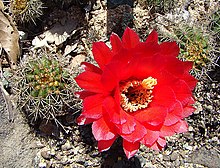| Soehrensia grandiflora | |
|---|---|

| |
|
Scientific classification
| |
| Kingdom: | Plantae |
| Clade: | Tracheophytes |
| Clade: | Angiosperms |
| Clade: | Eudicots |
| Order: | Caryophyllales |
| Family: | Cactaceae |
| Subfamily: | Cactoideae |
| Genus: | Soehrensia |
| Species: | S. grandiflora
|
| Binomial name | |
| Soehrensia grandiflora (R. Kiesling) Friedrich & Glaetzle
| |
Soehrensia grandiflora, is a species of Echinopsis found in Argentina. [1]
Description
Soehrensia grandiflora often branches from the base and forms small groups. The spherical to briefly cylindrical, green shoots are often tapered towards their tip. They reach heights of up to 16 cm (6.3 in) and have a diameter of 11.5 cm (4.5 in). There are nine to 14 wide and rounded ribs. The areoles on them are light brown and are up to 1.5 cm (0.59 in) apart. Light yellow, brown-tipped thorns emerge from them and become darker with age. The one to five central spines are 3.3 to 3.7 cm (1.3 to 1.5 in) long. The seven to twelve radial spines become quite strong over time and are up to 3 cm (1.2 in) long.
The short, funnel-shaped, red flowers are up to 8 cm (3.1 in) long and reach a diameter of 9 cm (3.5 in). [2]
Distribution
Soehrensia grandiflora is widespread in the Argentine province of Catamarca at medium altitudes of 2500 to 3000 meters.
Taxonomy
The first description as Lobivia crassicaulis by Roberto Kiesling was published in 1970. [3] Boris O. Schlumpberger placed the species in the genus Soehrensia in 2012. [4]
References
- ^ "Echinopsis crassicaulis". Tropicos. Retrieved 2019-08-22.
- ^ Anderson, Edward F.; Eggli, Urs (2005). Das grosse Kakteen-Lexikon (in German). Stuttgart (Hohenheim): Ulmer. p. 226. ISBN 3-8001-4573-1.
- ^ Kiesling, Roberto (1978). "El género Trichocereus (Cactaceae) : I: Las especies de la Rep. Argentina". Darwiniana. 21 (2/4). Instituto de Botánica Darwinion: 263–330. ISSN 0011-6793. JSTOR 23215595. Retrieved 2024-07-06.
- ^ Korotkova, Nadja; Aquino, David; Arias, Salvador; Eggli, Urs; Franck, Alan; Gómez-Hinostrosa, Carlos; Guerrero, Pablo C.; Hernández, Héctor M.; Kohlbecker, Andreas; Köhler, Matias; Luther, Katja; Majure, Lucas C.; Müller, Andreas; Metzing, Detlev; Nyffeler, Reto; Sánchez, Daniel; Schlumpberger, Boris; Berendsohn, Walter G. (2021-08-31). "Cactaceae at Caryophyllales.org – a dynamic online species-level taxonomic backbone for the family". Willdenowia. 51 (2). Botanic Garden and Botanical Museum Berlin, Freie Universitaet Berlin. doi: 10.3372/wi.51.51208. ISSN 0511-9618.
External links
-
 Media related to
Echinopsis crassicaulis at Wikimedia Commons
Media related to
Echinopsis crassicaulis at Wikimedia Commons -
 Data related to
Echinopsis crassicaulis at Wikispecies
Data related to
Echinopsis crassicaulis at Wikispecies
| Soehrensia grandiflora | |
|---|---|

| |
|
Scientific classification
| |
| Kingdom: | Plantae |
| Clade: | Tracheophytes |
| Clade: | Angiosperms |
| Clade: | Eudicots |
| Order: | Caryophyllales |
| Family: | Cactaceae |
| Subfamily: | Cactoideae |
| Genus: | Soehrensia |
| Species: | S. grandiflora
|
| Binomial name | |
| Soehrensia grandiflora (R. Kiesling) Friedrich & Glaetzle
| |
Soehrensia grandiflora, is a species of Echinopsis found in Argentina. [1]
Description
Soehrensia grandiflora often branches from the base and forms small groups. The spherical to briefly cylindrical, green shoots are often tapered towards their tip. They reach heights of up to 16 cm (6.3 in) and have a diameter of 11.5 cm (4.5 in). There are nine to 14 wide and rounded ribs. The areoles on them are light brown and are up to 1.5 cm (0.59 in) apart. Light yellow, brown-tipped thorns emerge from them and become darker with age. The one to five central spines are 3.3 to 3.7 cm (1.3 to 1.5 in) long. The seven to twelve radial spines become quite strong over time and are up to 3 cm (1.2 in) long.
The short, funnel-shaped, red flowers are up to 8 cm (3.1 in) long and reach a diameter of 9 cm (3.5 in). [2]
Distribution
Soehrensia grandiflora is widespread in the Argentine province of Catamarca at medium altitudes of 2500 to 3000 meters.
Taxonomy
The first description as Lobivia crassicaulis by Roberto Kiesling was published in 1970. [3] Boris O. Schlumpberger placed the species in the genus Soehrensia in 2012. [4]
References
- ^ "Echinopsis crassicaulis". Tropicos. Retrieved 2019-08-22.
- ^ Anderson, Edward F.; Eggli, Urs (2005). Das grosse Kakteen-Lexikon (in German). Stuttgart (Hohenheim): Ulmer. p. 226. ISBN 3-8001-4573-1.
- ^ Kiesling, Roberto (1978). "El género Trichocereus (Cactaceae) : I: Las especies de la Rep. Argentina". Darwiniana. 21 (2/4). Instituto de Botánica Darwinion: 263–330. ISSN 0011-6793. JSTOR 23215595. Retrieved 2024-07-06.
- ^ Korotkova, Nadja; Aquino, David; Arias, Salvador; Eggli, Urs; Franck, Alan; Gómez-Hinostrosa, Carlos; Guerrero, Pablo C.; Hernández, Héctor M.; Kohlbecker, Andreas; Köhler, Matias; Luther, Katja; Majure, Lucas C.; Müller, Andreas; Metzing, Detlev; Nyffeler, Reto; Sánchez, Daniel; Schlumpberger, Boris; Berendsohn, Walter G. (2021-08-31). "Cactaceae at Caryophyllales.org – a dynamic online species-level taxonomic backbone for the family". Willdenowia. 51 (2). Botanic Garden and Botanical Museum Berlin, Freie Universitaet Berlin. doi: 10.3372/wi.51.51208. ISSN 0511-9618.
External links
-
 Media related to
Echinopsis crassicaulis at Wikimedia Commons
Media related to
Echinopsis crassicaulis at Wikimedia Commons -
 Data related to
Echinopsis crassicaulis at Wikispecies
Data related to
Echinopsis crassicaulis at Wikispecies